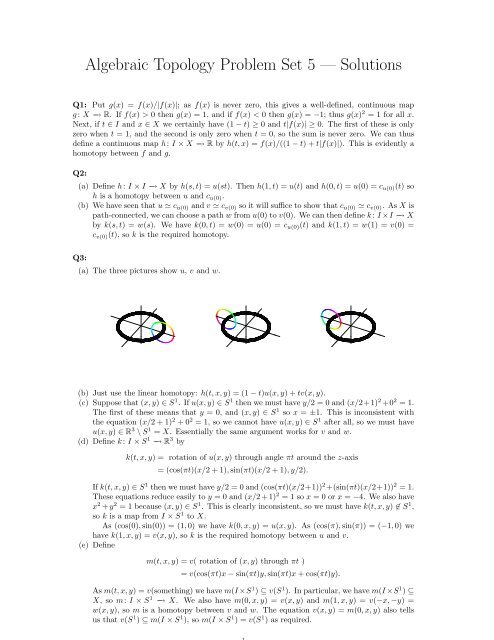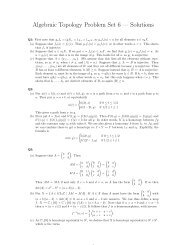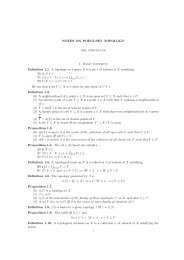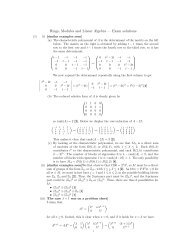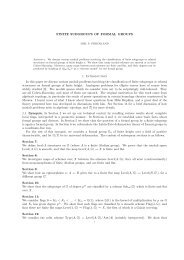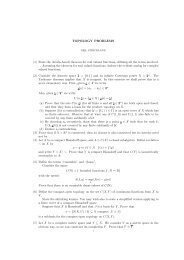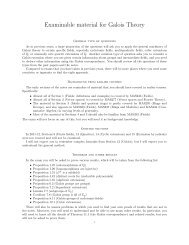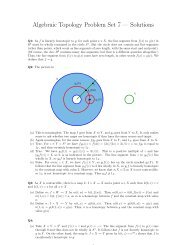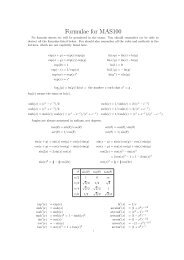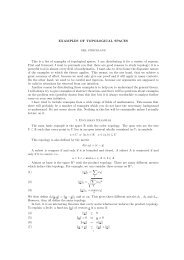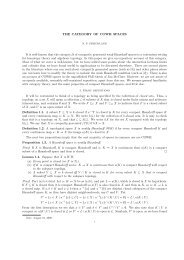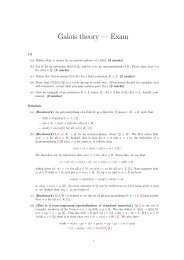Algebraic Topology Problem Set 5 â Solutions - Strickland, Neil
Algebraic Topology Problem Set 5 â Solutions - Strickland, Neil
Algebraic Topology Problem Set 5 â Solutions - Strickland, Neil
You also want an ePaper? Increase the reach of your titles
YUMPU automatically turns print PDFs into web optimized ePapers that Google loves.
<strong>Algebraic</strong> <strong>Topology</strong> <strong>Problem</strong> <strong>Set</strong> 5 — <strong>Solutions</strong><br />
Q1: Put g(x) = f(x)/|f(x)|; as f(x) is never zero, this gives a well-defined, continuous map<br />
g : X −→ R. If f(x) > 0 then g(x) = 1, and if f(x) < 0 then g(x) = −1; thus g(x) 2 = 1 for all x.<br />
Next, if t ∈ I and x ∈ X we certainly have (1 − t) ≥ 0 and t|f(x)| ≥ 0. The first of these is only<br />
zero when t = 1, and the second is only zero when t = 0, so the sum is never zero. We can thus<br />
define a continuous map h: I × X −→ R by h(t, x) = f(x)/((1 − t) + t|f(x)|). This is evidently a<br />
homotopy between f and g.<br />
Q2:<br />
(a) Define h: I × I −→ X by h(s, t) = u(st). Then h(1, t) = u(t) and h(0, t) = u(0) = c u(0) (t) so<br />
h is a homotopy between u and c u(0) .<br />
(b) We have seen that u ≃ c u(0) and v ≃ c v(0) so it will suffice to show that c u(0) ≃ c v(0) . As X is<br />
path-connected, we can choose a path w from u(0) to v(0). We can then define k : I ×I −→ X<br />
by k(s, t) = w(s). We have k(0, t) = w(0) = u(0) = c u(0) (t) and k(1, t) = w(1) = v(0) =<br />
c v(0) (t), so k is the required homotopy.<br />
Q3:<br />
(a) The three pictures show u, v and w.<br />
(b) Just use the linear homotopy: h(t, x, y) = (1 − t)u(x, y) + tv(x, y).<br />
(c) Suppose that (x, y) ∈ S 1 . If u(x, y) ∈ S 1 then we must have y/2 = 0 and (x/2+1) 2 +0 2 = 1.<br />
The first of these means that y = 0, and (x, y) ∈ S 1 so x = ±1. This is inconsistent with<br />
the equation (x/2 + 1) 2 + 0 2 = 1, so we cannot have u(x, y) ∈ S 1 after all, so we must have<br />
u(x, y) ∈ R 3 \ S 1 = X. Essentially the same argument works for v and w.<br />
(d) Define k : I × S 1 −→ R 3 by<br />
k(t, x, y) = rotation of u(x, y) through angle πt around the z-axis<br />
= (cos(πt)(x/2 + 1), sin(πt)(x/2 + 1), y/2).<br />
If k(t, x, y) ∈ S 1 then we must have y/2 = 0 and (cos(πt)(x/2+1)) 2 +(sin(πt)(x/2+1)) 2 = 1.<br />
These equations reduce easily to y = 0 and (x/2 + 1) 2 = 1 so x = 0 or x = −4. We also have<br />
x 2 + y 2 = 1 because (x, y) ∈ S 1 . This is clearly inconsistent, so we must have k(t, x, y) ∉ S 1 ,<br />
so k is a map from I × S 1 to X.<br />
As (cos(0), sin(0)) = (1, 0) we have k(0, x, y) = u(x, y). As (cos(π), sin(π)) = (−1, 0) we<br />
have k(1, x, y) = v(x, y), so k is the required homotopy between u and v.<br />
(e) Define<br />
m(t, x, y) = v( rotation of (x, y) through πt )<br />
= v(cos(πt)x − sin(πt)y, sin(πt)x + cos(πt)y).<br />
As m(t, x, y) = v(something) we have m(I ×S 1 ) ⊆ v(S 1 ). In particular, we have m(I ×S 1 ) ⊆<br />
X, so m: I × S 1 −→ X. We also have m(0, x, y) = v(x, y) and m(1, x, y) = v(−x, −y) =<br />
w(x, y), so m is a homotopy between v and w. The equation v(x, y) = m(0, x, y) also tells<br />
us that v(S 1 ) ⊆ m(I × S 1 ), so m(I × S 1 ) = v(S 1 ) as required.
2<br />
Q4: Let the roots of f be {x 1 , . . . , x n }, listed in order so that x 1 < x 2 < . . . < x n . Suppose<br />
1 ≤ i < n. As f(x i ) = 0 = f(x i+1 ), the Mean Value Theorem tells us that f ′ (y i ) = 0 for some y i<br />
with x i < y i < x i+1 . This gives n − 1 roots y 1 , . . . , y n−1 of f ′ (x). However, f ′ (x) is a polynomial<br />
of degree n − 1, so it has at most n − 1 roots, so we must have found all of them. We thus have<br />
X = (−∞, x 1 ) ∪ (x 1 , x 2 ) ∪ . . . ∪ (x n−1 , x n ) ∪ (x n , +∞)<br />
Y = {y 1 , . . . , y n−1 } ⊂ X.<br />
Each of the finite intervals in X is homotopy equivalent to the single point of Y that it contains.<br />
The two infinite intervals are also contractible. Thus X is homotopy equivalent to Y with two<br />
extra points adjoined. More precisely, if we put Y ′ = Y ∪ {x 1 − 1, x n + 1} then the inclusion map<br />
Y ′ −→ X is a homotopy equivalence.<br />
x1 y1 x2 y2 x3<br />
Q5: Define<br />
U + = {(x, y, z) ∈ S 2 | z > 0}<br />
U − = {(x, y, z) ∈ S 2 | z < 0},<br />
so X = S 2 \ S 1 = U + ∪ U − , and U + ∩ U − = ∅. If x 2 + y 2 + z 2 = 1 and z ≠ 0 we must have<br />
x 2 + y 2 < 1 so (x, y) ∈ B<br />
◦ 2<br />
. Define f : U + −→ B<br />
◦ 2<br />
by f(x, y, z) = (x, y), and define g : B<br />
◦ 2<br />
−→ U +<br />
by g(x, y) = (x, y, √ 1 − x 2 − y 2 ). These maps show that U + is homeomorphic to B<br />
◦ 2<br />
, which is<br />
contractible. Similarly, U − is contractible. As X is the disjoint union of U + and U − , it is homotopy<br />
equivalent to the 2-point space {N, S}.<br />
Q6: First note that X is the set of points x ∈ R 2 for which r = ‖x‖ is not of the form (n + 1 2 )π.<br />
Moreover, ∂f/∂r = sin(r) = sin(‖x‖), so Y is the set of points where ‖x‖ has the form nπ. Thus,<br />
in the picture below, X is the whole plane with the red circles removed, and Y consists of the<br />
central point together with the blue circles.
3<br />
Let f : Y −→ X be the inclusion map, and let g : X −→ Y be the map indicated by the green<br />
arrows on the diagram. In other words, to get g(x), we move inwards or outwards from x the least<br />
possible distance to get to a point of Y . If y already lies in Y then g(y) = y; in other words, we<br />
have gf = 1 Y . The line segment from x to g(x) = fg(x) lies wholly within X, so we can define<br />
h(t, x) = (1 − t)fg(x) + tx to get a homotopy from fg to 1 X .<br />
We now give some formulae to make this more respectable. Write S = R \ {n + 1 2<br />
| n ∈ Z} and<br />
define q : S −→ Z by q(s) = the nearest integer to s. It is not hard to see that this is continuous;<br />
the only problematic points are the points n + 1 2<br />
, and we have excluded these from the domain.<br />
Moreover, if we let p: Z −→ S be the inclusion, then qp = 1 Z . Now define r : I × S −→ R by<br />
r(t, s) = (1 − t)pq(s) + ts ∈ R. As s ∈ S we have n − 1 2 < s < n + 1 2<br />
for some integer n and<br />
q(s) = n. It follows that n − 1 2 < r(t, s) < n + 1 2<br />
for all t ∈ I, and thus that r(t, s) ∈ S. We can<br />
thus think of r as a map I × S −→ S, giving a homotopy pq ≃ 1.<br />
For our formal definition of g, we put<br />
g(x) =<br />
{<br />
q(‖x‖/π)πx/‖x‖ if x ≠ 0<br />
0 if x = 0.<br />
Given that q is continuous, we see easily that g is continuous except possibly at x = 0. However,<br />
from the definition of q we see that g(x) = 0 whenever ‖x‖ < π/2, and using this we see that g is<br />
continuous at x = 0 as well.<br />
Now, if y ∈ Y \ {0} then ‖y‖ = nπ for some n ∈ Z so q(‖y‖/π) = n so g(y) = nπy/‖y‖ = y.<br />
Clearly we have g(y) = y if y = 0 as well, and this shows that gf = 1 Y .<br />
Next, define h: I × X −→ R 2 by<br />
h(t, x) = (1 − t)fg(x) + tx<br />
( ( ‖x‖<br />
= (1 − t)q<br />
π<br />
= r(t, ‖x‖/π)πx/‖x‖.<br />
)<br />
+ t ‖x‖<br />
π<br />
) πx<br />
‖x‖<br />
The first formula shows that h is continuous. Because r(t, s) ∈ S for all t ∈ I and s ∈ S, the last<br />
formula shows that h(t, x) ∈ X for all t ∈ I and x ∈ X. (Strictly sepeaking, we need to consider<br />
x = 0 separately, but that is easy). This gives the required homotopy.<br />
Q7:<br />
(i) There are various possible ways to answer this question. One possibility is to say that x is an<br />
endpoint if there is no path-connected open set U such that x ∈ U and U \{x} is disconnected.<br />
Suppose that x satisfies this definition and that f : X −→ Y is a homeomorphism with<br />
f(x) = y say. If V is a path-connected open subset of Y containing y then the set U = f −1 (V )<br />
is an open subset of X containing x. It is homeomorphic to V and thus path-connected. By<br />
our definition of endpoints, the set U \ {x} must be path-connected as well. Moreover, f<br />
gives a homeomorphism U \ {x} −→ V \ {y}, so V \ {y} is path-connected. This proves that<br />
y is an endpoint of Y , as required.<br />
Another possibility is to say that x is an endpoint of X if there is an open set U ⊂ X<br />
such that x ∈ U and a homeomorphism u: U −→ [0, 1) such that u(x) = 0. With any<br />
reasonable definition of “one-dimensional objects”, the two definitions will give the same<br />
answer. However, according to the first definition 0 is an endpoint of R 2 , but that is not the<br />
case according to the second definition.<br />
(ii) In the spirit of our first definition above, we could say that x is a multiple point of X if<br />
there is a path-connected open set U containing x such that U \ {x} has at least three<br />
path-components.<br />
In the spirit of our second definition, we could define<br />
W n = {re 2πik/n | 0 ≤ r < 1 and k ∈ Z} = {z ∈ C | z n ∈ [0, 1)},<br />
so W n consists of n line segments meeting at the origin. We could say that x is a multiple<br />
point if there is an open set U containing x and a homeomorphism f : U −→ W n with f(x) = 0<br />
for some n > 2.


